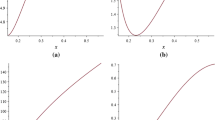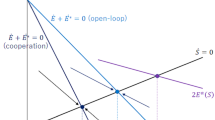Abstract
Transnational pollution is formulated as a differential game between two sovereign governments. The symmetric open loop Nash equilibrium is shown to yield more pollution than in a cooperative solution. A model of Stackelberg leadership in pollution control is also investigated. The possibility of limit cycles is illustrated, using bifurcation theory.
Similar content being viewed by others
References
T. Basar and B.J. Olsder,Dynamic Non-Cooperative Game Theory (Academic Press, 1982).
W.A. Brock and J. Sheinkman, The global asymptotic stability of optimal control with applications to dynamic economic theory, in:Applications of Control Theory to Economic Analysis, ed. J.D. Pitchford and S.J. Turnovsky (North-Holland, Amsterdam, 1977).
J.M. Conrad and L.J. Olson, Polluted control and resource management, Working Paper, Department of Agricultural Economics, Cornell University, New York (1990).
E. Dockner, Local stability analysis in optimal control problems with two state variables, in:Optimal Control Theory and Economic Analysis 2, ed. G. Feichtinger (North-Holland, Amsterdam, 1985).
C. Fershtman and M. Kamien, Dynamic duopolistic competition with sticky prices, Econometrica 55(1987)257.
B.A. Forster, Optimal consumption planning in a polluted environment, Econ. Record 49(1973)534.
B.A. Forster, Optimal pollution control with a non-constant exponential rate of decay, J. Environ. Econ. Manag. 2(1975)1.
J. Guckenheimer and P. Holmes,Non-Linear Oscillations, Dynamical Systems, and Bifurcation of Vector Fields (Springer, 1983).
M.C. Kemp, N.V. Long and K. Shimomura, Cyclical and non-cyclical redistributive taxation, Working Paper, Department of Economics, University of New South Wales, Australia (1990).
C.G. Plourde, A model of waste accumulation and disposal, Can. J. Econ. 5(1972)115.
C.G. Plourde and D. Yeung, A model of industrial pollution in a stochastic environment, J. Environ. Econ. Manag. 17(1989)100.
Author information
Authors and Affiliations
Rights and permissions
About this article
Cite this article
Long, N.V. Pollution control: A differential game approach. Ann Oper Res 37, 283–296 (1992). https://doi.org/10.1007/BF02071061
Issue Date:
DOI: https://doi.org/10.1007/BF02071061




